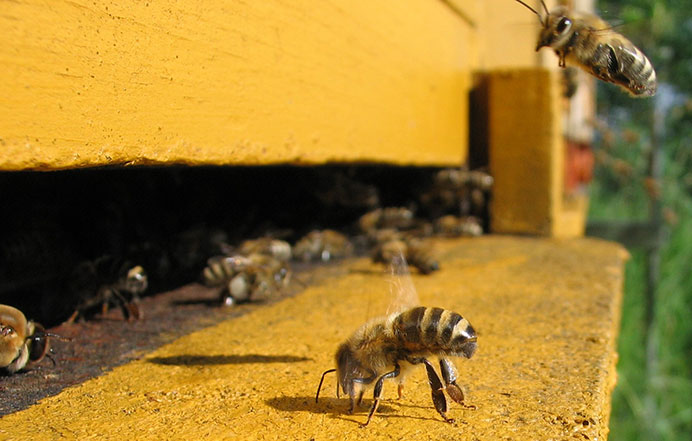Colony collapse disorder. Sounds reminiscent of some antagonizing societal problem threading its way through the plot of another early 50s, hard-boiled science-fiction movie, but while those hypothetical special effects would be hokey and unbelievable, this phenomenon is very real.
The disorder, as we know it outside of 20th-century cinema, occurs when a large percentage of a beehive’s work force simply disappears, leaving behind a lonely queen and a stockpile of food.
Sounds mysterious, but explanations for the phenomenon can be found, as usual, with environmental problems, in human actions. Those actions can be narrowed down to three aspects of what has been proclaimed as the Agricultural Revolution (which perhaps not coincidentally has its roots in Iowa farming), contributing to the steady decline of Iowa’s bee population: terraforming, pesticides/insecticides, and Iowa’s world famous corn and soybean crop.
Iowa is, according to our very own Natural History Museum, 98 percent terraformed. This means almost our entire state’s land mass has lost its natural state, including the fields of prairie flowers essential to bee’s life cycles. These have been replaced with fields of soybean and corn, which are unable to be pollinated, rendering a honeybee colony’s existence in an area useless.
This, combined with the use of pesticides and insecticides in the few areas where the bee population can scrape by, results in a detrimental environment for a creature so important to the proper functioning natural harmony of our planet. To put it simply, without bees, there are no flowering plants.
Though definitive science explicitly relating the decline in populations to the increase in pesticide/insecticide use remains murky, the evidence has been growing.
The Agricultural Revolution refers to a series of technological advancements in farming that resulted in a massive increase in crop output, especially grain output, worldwide. Norman Borlaug is considered the “godfather” of this revolution, a Midwestern native, born in sleepy Cresco, Iowa.
Borlaug, though heralded as the “Man Who Saved a Billion Lives” and earning himself a Nobel Prize, among many honors, his agriculture initiatives have been subject to much criticism in the postmodern 21st century, one of which we are seeing at home today with the slow disappearance of the native bee population — an essential cog in the ecological system of not only Iowa but anywhere where natural pollination is necessary to natural functioning environments.
The entire bee issue harks to a larger problem: At what point does human existence in the world take precedence over the natural world? The bottom line is human beings need to be fed. Corn and soybean remain as perhaps some of the more preferred crops for handling such (though Iowa’s corn goes mostly to feeding stock and making ethanol and corn syrup), yet the methods in which we do this seem to slowly destroy the environment. Particularly in the insect ecosystem, this not only remains essential to little critters such as honey bees but also to us as cognitive beings interacting in the same environment.
Perhaps we can leave it up to ever-reliable human ingenuity, which has fed the billions birthed from the Industrial Revolution on. In due time, when industrial agriculture wakes up to smell the pollen in the roses, maybe we’ll see a different kind of revolution in agriculture. Until then, let’s be good Iowans and use our gardening chemicals sparingly.



